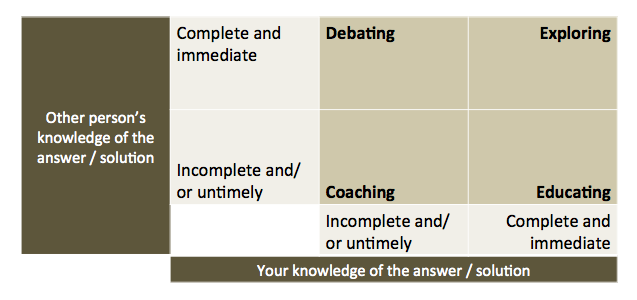Managers are expected to get their teams to deliver on the objectives that are established. Managers are also expected to keep their people happy and motivated. How can one accomplish these two seemingly incompatible expectations?
Let’s first distinguish management from leadership.
Management books often make a distinction between managers and leaders, depicting leadership as if it is more about heroics than management. [...] Managers are then advised to transform themselves to leaders, turning employees into willing followers, instead of herding them like sheep. [...] Separating leadership from management is like comparing women to humans. It doesn’t make sense. [...] Comparing women to men seems more logical to me. - Management 3.0: Leading Agile Developers, Developing Agile Leaders
I agree with Jurgen that leadership is one of the ways to accomplish a manager’s role.
Along the same lines, I hear from time to time conversations within Agile circles and read Agile related blog posts promoting soft leadership, leading without authority and laissez-faire [The latter is sometime mistakenly perceived to be self-organization. Self-organization is something else and requires clear boundaries, but that's for another post] as the answer to the management conundrum. Is that really the silver-bullet?
In almost all organizations, the manager’s role is fairly similar.
Management in all business and organizational activities is the act of getting people together to accomplish desired goals and objectives using available resources efficiently and effectively. Management comprises planning, organizing, staffing, leading or directing, and controlling an organization (a group of one or more people or entities) or effort for the purpose of accomplishing a goal. [...] Since organizations can be viewed as systems, management can also be defined as human action, including design, to facilitate the production of useful outcomes from a system. This view opens the opportunity to ‘manage’ oneself, a pre-requisite to attempting to manage others. - wikipedia
For a large number of individuals in management responsibility, authority is perceived to be the most effective tool to ensure compliance and to get people to do with is expected. Please bear with me, the analogy isn’t perfect but the image is powerful. For me, authority is similar to carrying a gun [or whatever your preferred weapon happens to be].
It is easy to obtain compliance and get people to do what we tell them to do when we – the managers – are the only people carrying a weapon. It is especially true if the weapon is constantly out of the holster and pointing directly at the team [figuratively speaking, of course]. So authority gets us compliance (for most part) and may allow us to meet our objectives (some of the time) but authority doesn’t bring the best out of people. Authority certainly doesn’t make people happy and motivated.
On the other hand, if we aim to keep people happy and motivated first, we are more likely to adopt a laissez-faire approach.
Lewin often characterized organizational management styles and cultures in terms of leadership climates defined by (1) authoritarian, (2) democratic and (3) laissez-faire work environments. Authoritarian environments are characterized where the leader determines policy with techniques and steps for work tasks dictated by the leader in the division of labor. The leader is not necessarily hostile but is aloof from participation in work and commonly offers personal praise and criticism for the work done. Democratic climates are characterized where policy is determined through collective processes with decisions assisted by the leader. Before accomplishing tasks, perspectives are gained from group discussion and technical advice from a leader. Members are given choices and collectively decide the division of labor. Praise and criticism in such an environment are objective, fact minded and given by a group member without necessarily having participated extensively in the actual work. Laissez-faire Environments give freedom to the group for policy determination without any participation from the leader. The leader remains uninvolved in work decisions unless asked, does not participate in the division of labor, and very infrequently gives praise. - wikipedia
When nobody carries a weapon, such as in the case of laissez-faire leadership style, people are freer to select goals that appeal to them and are more likely to be successful at reaching their objectives. Unfortunately, managing people (as in the wikipedia definition “getting people together to accomplish desired goals and objectives”) becomes extremely difficult and maybe impossible in a business context (trust me, we have tried that unsuccessfully).
To be an agile manager doesn’t mean to avoid using authority and to strictly rely on our influencing capabilities. It doesn’t mean to let people determine the business orientation that the organization will be taking either. As in many fruitless debates, taking an “either or” perspective doesn’t lead to the best answer. Agile managers need to be able to use authority, but not as their primary tool.
Let me explain.
Agile managers need to take the time to explain the objectives they aim to achieve and get people to follow them (leadership) into attempting to reach the objectives. Just like good diplomats, agile managers should begin with good listening skills, influence, and negotiation when they are faced with people resistance and challenges. Only in extreme cases should we turn to authority to get people to do what we need them to do. Like many things in life, using authority comes at a cost (diminished commitment from the team, reduced motivation) and as such, should be used wisely.
This leads me to my last point. In addition to management skills, people’s tolerance to stress needs to determine if they should be entitled to manage a team. As most psychometric tests can tell, we – humans – tend to operate differently when we are within our comfort zone (low stress) or outside our comfort zone (high stress). While in our comfort zone, we usually take advantage of many of our built-in or acquired skills which doesn’t increase one’s anxiety level. By contrast, stepping too much outside our comfort zone leads to decreased performance and substantially increased anxiety levels. People for who management is within their comfort zone or people who have better abilities to deal with stress are less likely to use authority as their primary tool. As such, agile managers are more likely to wait until the situation is critical before they even think of going “Clint Eastwood” on people.
So next time you are thinking of promoting someone in a management position, do not simply look for their skills. Assess their ability to manage their stress level.
 After giving this introduction training to over a hundred people managers, I have decided to make the presentation material available to the general public in an attempt to help organizations successfully transition to Agile.
After giving this introduction training to over a hundred people managers, I have decided to make the presentation material available to the general public in an attempt to help organizations successfully transition to Agile.

Recent Comments